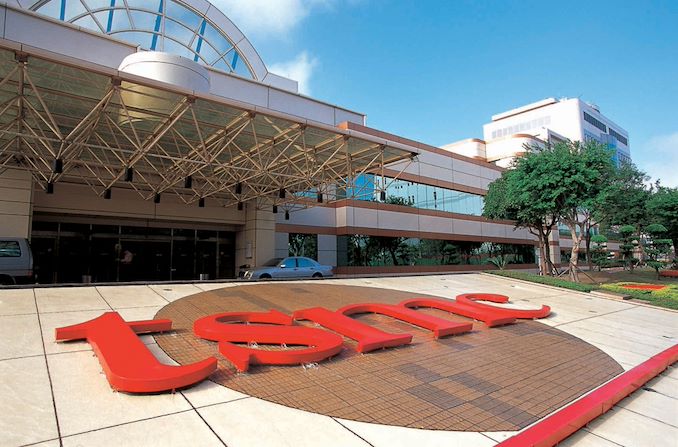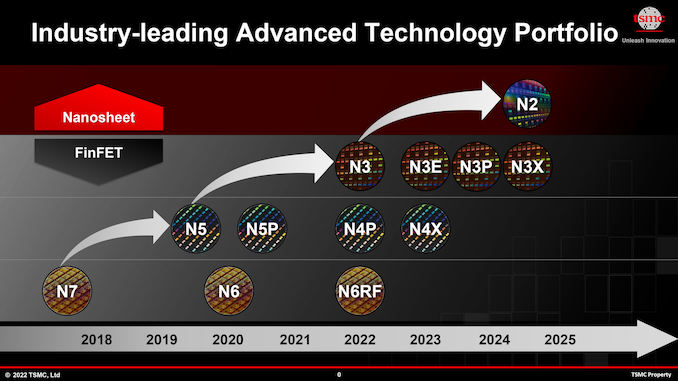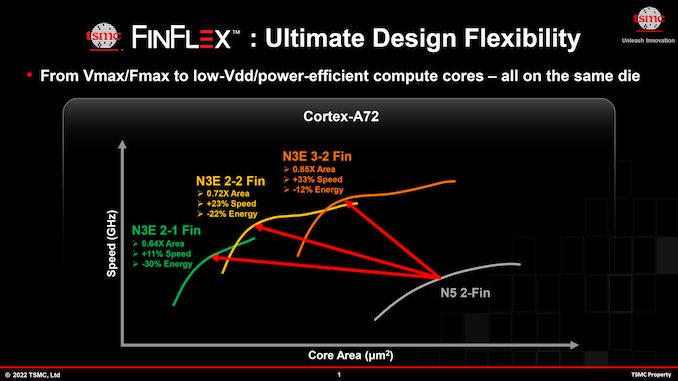TSMC Readies Five 3nm Process Technologies, Adds FinFlex For Design Flexibility
by Anton Shilov on June 16, 2022 3:10 PM EST
Taiwan Semiconductor Manufacturing Co. on Thursday kicked off its 2022 TSMC Technology Symposium, where the company traditionally shares it process technology roadmaps as well as its future expansion plans. One of the key things that TSMC is announcing today are its leading-edge nodes that belong to its N3 (3 nm class) and N2 (2nm class) families that will be used to make advanced CPUs, GPUs, and SoCs in the coming years.
N3: Five Nodes Over Next Three Years
As fabrication processes get more complex, their pathfinding, research, and development times get stretched out as well, so we no longer see a brand-new node emerging every two years from TSMC and other foundries. With N3, TSMC's new node introduction cadence is going to expand to around 2.5 years, whereas with N2, it will stretch to around three years.
This means that TSMC will need to offer enhanced versions of N3 in order to meet the needs of its customers who are still looking for a performance per watt improvement as well as transistor density bump every year or so. Another reason why TSMC and its customers need multiple versions of N3 is because the foundry's N2 relies on all-new gate-all-around field-effect transistors (GAA FETs) implemented using nanosheets, which is expected to come with higher costs, new design methodologies, new IP, and many other changes. While developers of bleeding-edge chips will be quick to jump to N2, many of TSMC's more rank & file customers will stick to various N3 technologies for years to come.
At its TSMC Technology Symposium 2022, the foundry talked about four N3-derived fabrication processes (for a total of five 3 nm-class nodes) — N3E, N3P, N3S, and N3X — set to be introduced over the coming years. These N3 variants are slated to deliver improved process windows, higher performance, increased transistor densities, and augmented voltages for ultra-high-performance applications. All these technologies will support FinFlex, a TSMC "secret sauce" feature that greatly enhances their design flexibility and allows chip designers to precisely optimize performance, power consumption, and costs.
| Advertised PPA Improvements of New Process Technologies Data announced during conference calls, events, press briefings and press releases |
||||||||
| TSMC | ||||||||
| N4 vs N5 |
N4P vs N5 |
N4P vs N4 |
N4X vs N5 |
N4X vs N4P |
N3 vs N5 |
N3E vs N5 |
||
| Power | lower | -22% | - | ? | ? | -25-30% | -34% | |
| Performance | higher | +11% | +6% | +15% or more |
+4% or more |
+10-15% | +18% | |
| Logic Area Reduction* % Logic Density* |
0.94x -6% 1.06x |
0.94x -6% 1.06x |
- |
? |
? |
0.58x -42% 1.7x |
0.625x -37.5% 1.6x |
|
| Volume Manufacturing |
2022 | 2023 | H2 2022 | 2023 | 2023 | H2 2022 | Q2/Q3 2023 | |
*Note that TSMC only started to publish transistor density enhancements for analog, logic, and SRAM separately around 2020. Some of the numbers still reflect 'mixed' density consisting of 50% logic, 30% SRAM, and 20% analog.
N3 and N3E: On Track for HVM
TSMC's first 3 nm-class node is called N3 and this one is on track to start high volume manufacturing (HVM) in the second half of this year. Actual chips are set to be delivered to customers in early 2023.This technology is mostly aimed at early adopters (read: Apple and the like) who can invest in leading-edge designs and would benefit from the performance, power, area (PPA) advantages offered by leading-edge nodes. But as it's tailored for particular types of applications, N3 has a relatively narrow process window (a range of parameters that produce a defined result), which may not be suitable for all applications in terms of yields.
This is when N3E comes into play. The new technology enhances performance, lowers power, and increases the process window, which results in higher yields. But the trade-off is that the node features a slightly reduced logic density. When compared to N5, N3E will offer a 34% reduction in power consumption (at the same speed and complexity) or an 18% performance improvement (at the same power and complexity), and will increase logic transistor density by 1.6x.
It is noteworthy that, based on data from TSMC, N3E will offer higher clockspeeds than even N4X (due in 2023). However the latter will also support ultra-high drive currents and voltages of above 1.2V, at which point it will be able to offer unbeatable performance, but with very high power consumption.
In general, N3E looks to be a more versatile node than N3, which is why it is not surprising that TSMC has more '3nm tape outs' at this point than it had with its 5 nm-class node at a similar point of its development.
Risk production of chips using N3E is set to start in the coming weeks (i.e., in Q2 or Q3 2022) with HVM set for mid-2023 (again, TSMC does not disclose whether we are talking about Q2 or Q3). So expect commercial N3E chips to be available in late 2023 or early 2024.
N3P, N3S, and N3X: Performance, Density, Voltages
N3's improvements do not stop with N3E. TSMC is set to bring out N3P, a performance-enhanced version of its fabrication process, as well as N3S, density-enhancing flavor of this node, some time around 2024. Unfortunately, TSMC is not currently disclosing what improvements these variants will offer compared to baseline N3. In fact, at its Technology Symposium 2022, TSMC did not even show N3S in its roadmap and it only got mentioned by Kevin Zhang in a conversation. Bearing all this in mind, it is really not a good business to try guessing characteristics of N3S.
Finally, for those customers who need ultra-high performance no matter power consumption and costs, TSMC will offer N3X, which is essentially an ideological successor of N4X. Again, TSMC is not revealing details about this node other than that it will support high drive currents and voltages. We might speculate that N4X could use backside power delivery, but since we are talking about a FinFET-based node and TSMC only going to implement backside power rail in nanosheet-based N2, we are not sure this is the case. Nonetheless, TSMC probably has a number of aces up its sleeve when it comes to voltage increases and performance enhancements.
FinFlex: N3's Secret Sauce
Speaking of enhancements, we should definitely mention TSMC's secret sauce for N3: FinFlex technology. In short, FinFlex allows chip designers to precisely tailor their building blocks for higher performance, higher density, and lower power.
Update 6/17: The initial version of the story incorrectly referred standard cells and blocks as transistors, which has been corrected.
When using a FinFET-based node, chip designers can choose between different libraries using different standard cells. A standard cell is the most basic building block that performs a Boolean logic or storage function and consists of a group of transistors and interconnects. From math point of view, the same function can be performed (with the same result) using a standard cell of different configurations. But from manufacturability and operation point of view, different standard cell configurations are characterized by different performance, power consumption, and area. When developers need to minimize die size and save power at the cost of performance, they use small standard cells. But when they need to maximize performance at the trade-off of die size and higher power, they use large standard cells.
Currently, chip designers have to stick to one library/standard cells either for the whole chip or the whole block in a SoC design. For example, CPU cores can be implemented using 3-2 fin blocks to make them run faster, or 2-1 fin standard cells to reduce their power consumption and footprint. This is a fair tradeoff, but it's not ideal for all cases, especially when we are talking about 3 nm-class nodes that will be more expensive to use than existing technologies.
For N3, TSMC's FinFlex technology will allow chip designers to mix and match different kinds of standard cells within one block to precisely tailor performance, power consumption, and area. For complex structures like CPU cores, such optimizations give a lot of opportunities to increase core performance while still optimizing die sizes. So, we are eager to see how SoC designers will be able to take advantage of FinFlex in the looming N3 era.
FinFlex is not a substitute for node specialization (performance, density, voltages) as process technologies have greater differences than the ibraries or transistor structures within a single process technology, but FinFlex looks to be a good way to optimize performance, power, and costs for TSMC's N3 node. Ultimately, this technology will bring the flexibility of FinFET-based nodes a little closer to that of nanosheet/GAAFET-based nodes, which are slated to offer adjustable channel widths to get higher performance or reduce power consumption.
Summary
Like TSMC's N7 and N5, N3 will be another family of long-lasting nodes for the world's largest contrast maker of semiconductors. Especially with the jump to nanosheet-based GAAFETs coming up at 2nm for TSMC, the 3nm family will be the final family of "classic" leading-edge FinFET nodes from the firm, and one that a lot of customers will stick to for several years (or more). Which, in turn, is why TSMC is prepping multiple versions of N3 tailored for different applications – as well as FinFlex technology to give chip designers some additional flexibility with their designs.
The first N3 chips are set to enter production in the coming months and arrive to the market in early 2023. Meanwhile, TSMC will keep producing semiconductors using its N3 nodes long after it introduces its N2 process technology in 2025.












43 Comments
View All Comments
Rictorhell - Thursday, June 16, 2022 - link
I am very much looking forward to iWatch's with improved battery life, 2tb micro SDXC cards, whatever innovations may come from this new process node.chrysrobyn - Thursday, June 16, 2022 - link
> I am very much looking forward to iWatch's with improved battery life, 2tb micro SDXC cards, whatever innovations may come from this new process node.I'm afraid Apple Watch battery use (and other smart watches) are dominated by screen use and other activities, not the CPU which is inactive / sleeping 99+% of the time. It's more likely that the FDSOI technologies by GF would provide lower sleep power than the ultra performance nodes. Similarly, nonvolatile technologies like SSDs / SDXC are dominated by other things, like the capacitors for flash, and these high density / high performance transistors will not impact at all.
These transistors are 100% going to be used where ultra-density is what's important, and that means CPUs where the distance between transistors dominates the speed they can run at. Think smart phones, video games, PCs, servers, tablets.
deil - Monday, June 20, 2022 - link
what will be worth it, is that all sensors will be on lower nodes as well, as the legacy nodes are overbooked to hell and it will be worth it to make sensors on something like 80nm, because of the dedlines and waiting time on 2u or higher nodes. Power usage gains should be quite nice this gen.I still wait for solid state batteries which would make belts in those devices into 20x as big battery and would make those finally hold charge as long as their analog predecesors.
Bobbyjones - Thursday, June 16, 2022 - link
TSMC has finally hit a wall. N3 is delayed and yields are bad, hence why Apple wont use it for the iphone 14 this year. But instead will ship first with the tiny Intel Meteor Lake IGP dies in Q2 2023 or an iPad refresh in 2023. And now they are extending the N3 family through 2025. Just like they extended N5/N4 family because of the N3 issues. If Intel keeps their current pace and roadmap they will match TSMC in 2024 and surpass them in 2025.techjunkie123 - Thursday, June 16, 2022 - link
Intel's execution has been so poor recently that their aggressive fab roadmap seems unrealistic to me. Intel 4 by 2023, Intel 3 by 2024, and Intel 20A/18A by 2024-2025 seems very aggressive. This is from a company that is currently struggling to deliver Alchemist (drivers?), Sapphire Rapids (memory controller? chiplets?) and Ponte Vecchio (chiplets?). Alder Lake was the only timely launch recently, and that is a monolithic die on a mature node...Let's see if Intel can deliver, but I am somewhat doubtful....
kwohlt - Sunday, June 19, 2022 - link
I'm not going to comment on whether or not Intel hits their node roadmap, but Alchemist Drivers, SPR delays, and Ponte Vecchio issues are all unrelated, different departments/teams from nodes.SiliconFly - Sunday, June 26, 2022 - link
Intel's execution was very poor in the past because it was being run by stupid bean counters rather than real engineers (like in amd, nvidia, etc).Now it's being run by a real engineer who knows about engineering silicon. And they're doing all the right things. If they deliver Intel 4 on time, the rest will be history. And it appears it's well on track.
ballsystemlord - Thursday, June 16, 2022 - link
Maybe I missed it, but I don't see the word "delayed" in this article. Or anything related to being unable to maintain their goals.I do see that getting to the smallest sizes is getting harder for them. But that's hardly a surprise, especially with many of the TwinScan EUV machines being delivered and installed late.
dotjaz - Friday, June 17, 2022 - link
It's not delayed. TSMC is sticking to their timeline. TSMC only officially stayed a timeline in April 2020, and that was 22H2. There was a estimated risk production timeline in 2019 that shows N3 risk production around 2021-2022 time frame.http://www.gizmochina.com/2020/04/17/tsmc-3nm-proc...
TouchdownTom9 - Thursday, June 16, 2022 - link
Bobby, what you are saying implies Intel sticking to its road map, which has Intel 4 appearing in Q3 '22 and Intel 3 in Q3'23. Forget Q3'22--what product is using intel 4 this at any time this year? What Intel product will be using intel 3 in 2023? These are both rhetorical questions, because nothing on Intel's CPU roadmap lines up with its foundry roadmap. Raptor lake (still 7) is Q4 this year (at best), and Meteor Lake (4) will be mid next year for just mobile parts (desktop well after that). While TSMC is having delays on 3nm, the key takeaway here is that Intel's road map is out of touch with actual products hitting the market. If intel wants the node lead, they have to meet their deadlines and have shown no ability to do so yet. If Intel gets their 20a node products into market prior to TSMC getting 2nm into market, then they may challenge TSMC for the lead and take it, but I have serious doubts about their ability to meet deadlines and to do so with strong yields as they have yet to accomplish that in the last 8 years.